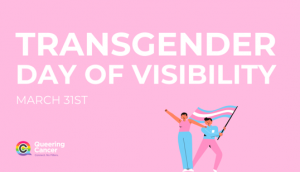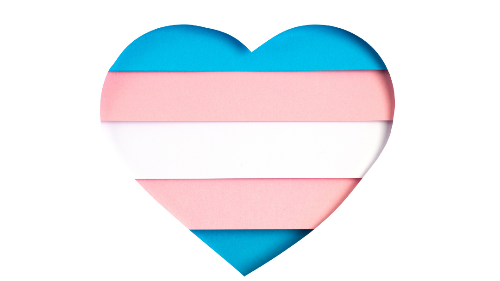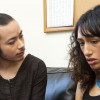
This post was written for International Trans Day of Visibility (March 31).
TDoV is “dedicated to celebrating trans people and raising awareness of discrimination faced by transgender people worldwide” (The Canadian Centre for Gender + Sexual Diversity). Queering Cancer join in celebrating transgender people, while also bringing awareness to the discrimination they can face in the healthcare setting, including cancer care settings.
As part of the Cancer’s Margins project, a study co-authored by Evan Taylor and Mary Bryson (2016) describes the results of interviews conducted with 10 trans or gender-nonconforming individuals (all of whom were assigned female at birth) who had been treated for breast or gynaecological cancers. One of the major themes in participants’ discussion of their cancer care experience related to the fact that breast and gynaecological cancers are considered and labelled as “women’s cancers”. Participants shared experiences of feeling unwelcome in waiting rooms and clinics, with some even being asked to leave these spaces.
These individuals also found that their cancer care providers were not knowledgeable of if or how their hormone treatments (as part of gender-affirming care) would impact their cancer treatments. They also had significant difficulty finding information on the Internet that was relevant to them. To quote one participant, ‘‘There’s certainly no trans* stuff—not even online—that I could find or that was what I needed.’’ Accessing peer support was also a challenge. Support groups specific to trans people with cancer are uncommon, and therefore not always an option for patients. Informal peer support was often more useful than formal peer support programs, whose very infrastructure often erased transgender individuals; this participant quote perfectly illustrates this erasure:
“I did access their peer support program, I tried. I said, ‘Can you look, can you key word search for FTM or trans*, anybody trans*?’ They’re like, ‘No, we can’t. Nothing came up. Do you want a lesbian or do you want a gay?’ I said, ‘I don’t want to talk to a lesbian. That’s a different thing. And I don’t want to talk to a gay man.’ And they ask, ‘Well, do you want a man or a woman?’ So, you have to choose all these things and none of them fit. It was so uncomfortable. There’s the lesbian group, and the gay group, but I didn’t really feel like I fit into any of those.’’
While Taylor and Bryson’s study covers interviews with just 10 people, the themes raised by participants truly highlight the need for increased visibility of transgender individuals in the cancer care system. We need to de-gender cancer and cancer treatment, and not make assumptions about who “belongs” in cancer treatment clinics based on patients’ gender expression. We need more cancer screening information aimed at transgender individuals. We need increased research on the intersection between cancer care and gender-affirming care – and this research needs to be translated to cancer care providers, so that they can relay important and relevant information to their patients. We need more formal peer support for transgender people diagnosed and living with cancer.
Our Information database has a number of resources for transgender individuals with cancer, including from the Cancer’s Margins project. If you are aware of any other resources, please contact us and let us know! We are always looking to expand our database, and want to make this information as accessible as possible.
By the way, trans* is an umbrella term that refers to a number of different identities within the gender identity spectrum including transgender, transman, transwoman, genderqueer, non-binary, two-spirit, genderfluid and more.
Reference
Taylor, E. T., & Bryson, M. K. (2016). Cancer’s Margins: Trans* and gender nonconforming people’s access to knowledge, experiences of cancer health, and decision-making. LGBT Health, 3(1), 79-89. https://doi.org/10.1089/lgbt.2…


